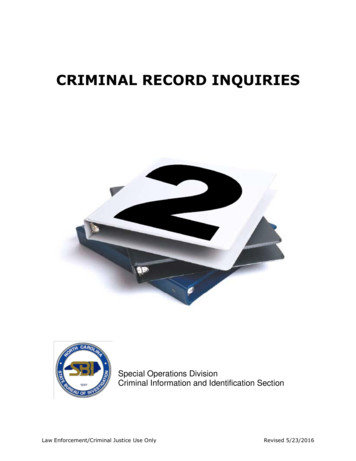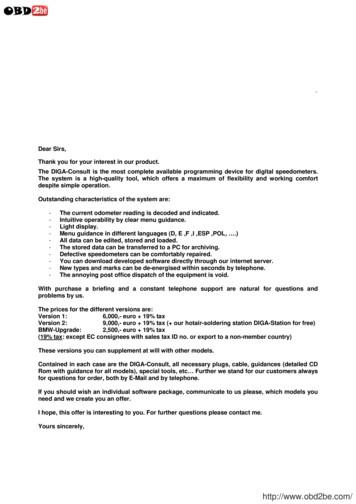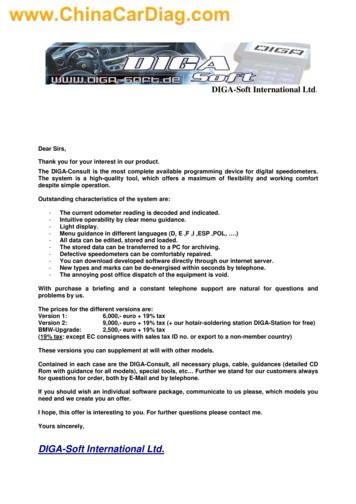Payment Processor Relationships Revised Guidance
Financial Institution LetterFIL-3-2012January 31, 2012Federal Deposit Insurance Corporation550 17th Street NW, Washington, D.C. 20429-9990Payment Processor RelationshipsRevised Guidance (Revised July 2014)Summary: Attached is revised guidance describing potential risks associated with relationships with third-partyentities that process payments for telemarketers, online businesses, and other merchants (collectively"merchants"). These relationships can pose increased risk to institutions and require careful due diligence andmonitoring. This guidance outlines certain risk mitigation principles for this type of activity.Statement of Applicability to Institutions with Total Assets under 1 Billion: This guidance applies to allFDIC-supervised financial institutions that have relationships with third-party payment processors.Distribution:FDIC-Supervised InstitutionsSuggested Routing:Chief Executive OfficerExecutive OfficersCompliance OfficerChief Information OfficerBSA OfficerHighlights: Related Topics:Guidance on Payment Processor Relationships (FIL 127-2008,November 2008)Consumer Protection, Compliance Risk, and Risk ManagementFDIC Guidance for Managing Third-Party Risk (FIL 44-2008, June2008)FFIEC Handbook on Retail Payment Systems (February 2010)FFIEC Handbook on Outsourcing Technology Services (June 2004)FFIEC Bank Secrecy Act/Anti-Money Laundering (BSA/AML)Examination Manual (April 2010)Managing Risks in Third-Party Payment Processor Relationships(Summer 2011 Supervisory Insights Journal)Attachment: Revised Guidance on Payment Processor RelationshipsContacts:Kathryn Weatherby, Examination Specialist (Fraud), Division of RiskManagement Supervision, at kweatherby@fdic.gov or (703) 2540469 John Bowman, Review Examiner, Division of Depositor andConsumer Protection, at jbowman@fdic.gov or (202) 898-6574Note:FDIC Financial Institution Letters may be accessed from the FDIC'sWeb site at o receive Financial Institution Letters electronically, please tml. Paper copies maybe obtained through the FDIC’s Public Information Center, 3501Fairfax Drive, E-1002, Arlington, VA 22226 (877-275-3342 or 703562-2200). Account relationships with third-party entities thatprocess payments for merchants require carefuldue diligence, close monitoring, and prudentunderwriting.Account relationships with high-risk entities poseincreased risks, including potentially unfair ordeceptive acts or practices under Section 5 of theFederal Trade Commission Act.Certain types of payment processors may poseheightened money laundering and fraud risks ifmerchant client identities are not verified andbusiness practices are not reviewed.Financial institutions should assess risk tolerancein their overall risk assessment program anddevelop policies and procedures addressing duediligence, underwriting, and ongoing monitoring ofhigh-risk payment processor relationships.Financial institutions should be alert to consumercomplaints or unusual return rates that suggest theinappropriate use of personal account informationand possible deception or unfair treatment ofconsumers.Financial institutions should act promptly whenfraudulent or improper activities occur relating to apayment processor, including possibly terminatingthe relationship.Improperly managing these risks may result in theimposition of enforcement actions, such as civilmoney penalties or restitution orders.
Financial Institution LetterFIL-3-2012January 31, 2012Revised Guidance on Payment Processor RelationshipsThe FDIC has recently seen an increase in the number of relationships between financialinstitutions and payment processors in which the payment processor, who is a deposit customerof the financial institution, uses its relationship to process payments for third-party merchantclients. Payment processors typically process payments either by creating and depositingremotely created checks (RCCs)—often referred to as “Demand Drafts”—or by originatingAutomated Clearing House (ACH) debits on behalf of their merchant customers. The paymentprocessor may use its own deposit account to process such transactions, or it may establishdeposit accounts for its merchant clients.While payment processors generally effect legitimate payment transactions for reputablemerchants, the risk profile of such entities can vary significantly depending on the make-up oftheir customer base. For example, payment processors that deal with telemarketing and onlinemerchants may have a higher risk profile because such entities have tended to display a higherincidence of consumer fraud or potentially illegal activities than some other businesses. Giventhis variability of risk, payment processors must have effective processes for verifying theirmerchant clients’ identities and reviewing their business practices. Payment processors that donot have such processes can pose elevated money laundering and fraud risk for financialinstitutions, as well as legal, reputational, and compliance risks if consumers are harmed.Financial institutions should understand, verify, and monitor the activities and the entities relatedto the account relationship. Although all of the core elements of managing third-party risk shouldbe considered in payment processor relationships (e.g., risk assessment, due diligence, andoversight), managing this risk poses an increased challenge for the financial institution whenthere may not be a direct customer relationship with the merchant. For example, it may bedifficult to obtain necessary information from the payment processor, particularly if a merchantis also a payment processor, resulting in a “nested” payment processor or “aggregator”relationship.Financial institutions should ensure that their contractual agreements with payment processorsprovide them with access to necessary information in a timely manner. These agreements shouldalso protect financial institutions by providing for immediate account closure, contracttermination, or similar action, as well as establishing adequate reserve requirements to coveranticipated charge backs. Accordingly, financial institutions should perform due diligence andaccount monitoring appropriate to the risk posed by the payment processor and its merchant1
base. Risks associated with this type of activity are further increased if neither the paymentprocessor nor the financial institution performs adequate due diligence on the merchants forwhich payments are originated. Financial institutions are reminded that they cannot rely solelyon due diligence performed by the payment processor. The FDIC expects a financial institutionto adequately oversee all transactions and activities that it processes and to appropriately manageand mitigate operational risks, Bank Secrecy Act (BSA) compliance, fraud risks, and consumerprotection risks, among others.Potential Risks Arising from Payment Processor RelationshipsDeposit relationships with payment processors expose financial institutions to risks notcustomarily present in relationships with other commercial customers. These include increasedoperational, strategic, credit, compliance, and transaction risks. In addition, financial institutionsshould consider the potential for legal, reputational, and other risks, including risks associatedwith a high or increasing number of customer complaints and returned items, and the potentialfor claims of unfair or deceptive practices. Financial institutions that fail to adequately managethese relationships may be viewed as facilitating a payment processor’s or merchant client’sfraudulent or unlawful activity and, thus, may be liable for such acts or practices. In such cases,the financial institution and responsible individuals have been subject to a variety of enforcementand other actions. Financial institutions must recognize and understand the businesses andcustomers with which they have relationships and the liability risk for facilitating or aiding andabetting consumer unfairness or deception under Section 5 of the Federal Trade CommissionAct.1Financial institutions should be alert for payment processors that use more than one financialinstitution to process merchant client payments or that have a history of moving from onefinancial institution to another within a short period. Processors may use multiple financialinstitutions because they recognize that one or more of the relationships may be terminated as aresult of suspicious activity.Financial institutions should also be on alert for payment processors that solicit businessrelationships with troubled financial institutions in need of capital. In such cases, paymentprocessors will identify and establish relationships with troubled financial institutions becausethese financial institutions may be more willing to engage in higher-risk transactions in exchangefor increased fee income. In some cases, payment processors have also committed to purchasingstock in certain troubled financial institutions or have guaranteed to place a large deposit with thefinancial institution, thereby providing additional, much-needed capital. Often, the targetedfinancial institutions are smaller, community banks that lack the infrastructure to properlymanage or control a third-party payment processor relationship.1Under Section 8 of the Federal Deposit Insurance Act, the FDIC has authority to enforce the prohibitions againstUnfair or Deceptive Acts or Practices (UDAP) in the Federal Trade Commission Act. UDAP violations can result inunsatisfactory Community Reinvestment Act ratings, compliance rating downgrades, restitution to consumers, andthe pursuit of civil money penalties.2
Financial institutions also should be alert to an increase in consumer complaints about paymentprocessors and/or merchant clients or an increase in the amount of returns or charge backs, all ofwhich may suggest that the originating merchant may be engaged in unfair or deceptive practicesor may be inappropriately obtaining or using consumers’ personal account information to createunauthorized RCCs or ACH debits. Consumer complaints may be made to a variety of sourcesand not just directly to the financial institution. They may be sent to the payment processor or theunderlying merchant, or directed to consumer advocacy groups or online complaint Web sites orblogs. Financial institutions should take reasonable steps to ensure they understand the type andlevel of complaints related to transactions that it processes. Financial institutions should alsodetermine, to the extent possible, if there are any external investigations of or legal actionsagainst a processor or its owners and operators during initial and ongoing due diligence ofpayment processors.Financial institutions should act promptly to minimize possible consumer harm, particularly incases involving potentially fraudulent or improper activities relating to activities of a paymentprocessor or its merchant clients. Appropriate actions include filing a Suspicious ActivityReport,2 requiring the payment processor to cease processing for a specific merchant, freezingcertain deposit account balances to cover anticipated charge backs, and/or terminating thefinancial institution’s relationship with the payment processor.Risk MitigationFinancial institutions should delineate clear lines of responsibility for controlling risks associatedwith payment processor relationships. Controls may include enhanced due diligence; effectiveunderwriting; and increased scrutiny and monitoring of high-risk accounts for an increase inunauthorized returns, charge backs, suspicious activity, and/or consumer complaints.Implementing appropriate controls for payment processors and their merchant clients can helpidentify payment processors that process items for fraudulent telemarketers, online scammers, orother unscrupulous merchants and help ensure that the financial institution is not facilitatingthese transactions. Appropriate oversight and monitoring of these accounts may require theinvolvement of multiple departments, including information technology, operations, BSA/antimoney laundering (AML), and compliance.Due Diligence and UnderwritingFinancial institutions should implement policies and procedures designed to reduce thelikelihood of establishing or maintaining inappropriate relationships with payment processorsused by unscrupulous merchants. Such policies and procedures should outline the bank’sthresholds for unauthorized returns, the possible actions that can be taken against paymentprocessors that exceed these standards, and methods for periodically reporting such activities tothe bank’s board of directors and senior management.2The U.S. Department of Treasury’s Regulation 31 (CFR 103.18) requires that every federally supervised bankingorganization file a SAR when the institution detects a known or suspected violation of federal law. Part 353 of theFDIC’s Rules and Regulations addresses SAR filing requirements and makes them applicable to all state-charteredfinancial institutions that are not members of the Federal Reserve System.3
As part of such policies and procedures, financial institutions should develop a processorapproval program that extends beyond credit risk management. This program should include adue diligence and underwriting policy that, among other things, requires a background check ofthe payment processor, its principal owners, and its merchant clients. This will help validate theactivities, creditworthiness, and business practices of the payment processor, as well as identifypotential problem merchants. Payment processors may also process transactions for otherpayment processors, resulting in nested payment processors or aggregator relationships. Thefinancial institution should be aware of these activities and obtain data on the nested processorand its merchant clients. Nested processors and aggregator relationships pose additionalchallenges as they may be extremely difficult to monitor and control; therefore, risk to theinstitution is significantly elevated in these cases.Controls and due diligence requirements should be robust for payment processors and theirmerchant clients. At a minimum, the policies and procedures should authenticate the processor’sbusiness operations and assess the entity’s risk level. An assessment should include: Identifying the major lines of business and volume for the processor’s customers; Reviewing the processor’s policies, procedures, and processes to determine the adequacyof due diligence standards for new merchants; Reviewing corporate documentation, including independent reporting services and, ifapplicable, documentation on principal owners; Reviewing the processor’s promotional materials, including its Web site, to determine thetarget clientele; Determining if the processor re-sells its services to a third party that may be referred to asan agent or provider of “Independent Sales Organization opportunities” or a “gatewayarrangement”3 and whether due diligence procedures applied to those entities aresufficient; Visiting the processor’s business operations center; Reviewing appropriate databases to ensure that the processor and its principal owners andoperators have not been subject to law enforcement actions; and, Determining whether any conflicts of interest exist between management and insiders ofthe financial institution.An Independent Sales Organization is an outside company contracted to procure new merchant relationships.Gateway arrangements are similar to Internet service providers that sell excess computer storage capacity to thirdparties, who in turn distribute computer services to other individuals unknown to the provider. The third party wouldmake decisions about who would be receiving the service, although the provider would be responsible for theultimate storage capacity.34
Financial institutions should require that payment processors provide information on theirmerchant clients, such as the merchant’s name, principal business activity, location, and salestechniques. The same information should be obtained if the merchant uses sub-merchants (oftencalled “affiliates”). Additionally, financial institutions should verify directly, or through thepayment processor, that the originator of the payment (i.e., the merchant) is operating alegitimate business. Such verification could include comparing the identifying information withpublic record, fraud databases, and a trusted third party, such as a consumer reporting agency orconsumer advocacy group, and/or checking references from other financial institutions. Thefinancial institution should also obtain independent operational audits of the payment processorto assess the accuracy and reliability of the processor’s systems. The more the financialinstitution relies on the payment processor for due diligence and monitoring of its merchantclient without direct financial institution involvement and verification, the more important it is tohave an independent review to ensure that the processor’s controls are sufficient and thatcontractual agreements between the financial institution and the third-party payment processorare honored.Ongoing MonitoringFinancial institutions that initiate transactions for payment processors should implement systemsto monitor for higher rates of returns or charge backs and/or high levels of RCCs or ACH debitsreturned as unauthorized or due to insufficient funds, all of which often indicate fraudulentactivity. This would include analyzing and monitoring the adequacy of any reserve balances oraccounts established to continually cover charge-back activity.Financial institutions are required to have a BSA/AML compliance program and appropriatepolicies, procedures, and processes for monitoring, detecting, and reporting suspicious activity.However, nonbank payment processors generally are not subject to BSA/AML regulatoryrequirements, and therefore some payment processors are more vulnerable to money laundering,identity theft, fraud schemes, and illicit transactions. The FFIEC BSA/AML ExaminationManual urges financial institutions to effectively assess and manage risk associated with thirdparty payment processors. As a result, a financial institution’s risk mitigation program shouldinclude procedures for monitoring payment processor information, such as merchant data,transaction volume, and charge-back history.Consumer complaints and/or high rates of return may be an indicator of unauthorized or illegalactivity. As such, financial institutions should establish procedures for regularly surveying thesources of consumer complaints that may be lodged with the payment processor, its merchantclients or their affiliates, or on publicly available complaint Web sites and/or blogs. This willhelp the institutions identify processors and merchants that may pose greater risk.Similarly, financial institutions should have a formalized process for periodically auditing theirthird-party payment processing relationships; including reviewing merchant client lists andconfirming that the processor is fulfilling contractual obligations to verify the legitimacy of itsmerchant clients and their business practices.5
ConclusionThe FDIC recognizes that financial institutions provide legitimate services for paymentprocessors and their merchant clients. However, to limit potential risks, financial institutionsshould implement risk mitigation policies and procedures that include oversight and controlsappropriate for the risk and transaction types of the payment processing activities. At aminimum, Board-approved policies and programs should assess the financial institution’s risktolerance for this type of activity, verify the legitimacy of the payment processor’s businessoperations, determine the character of the payment processor’s ownership, and ensure ongoingmonitoring of payment processor relationships for suspicious activity, among other
Federal Deposit Insurance Corporation 550 17th Street NW, Washington, D.C. 20429-9990 Financial Institution Letter FIL-3-2012 January 31, 2012 Payment Processor Relationships Revised Guidance (Revised July 2014) Summary: Attached is revised guidance describing poten
Student Training Manual/Workbook . 5 Law Enforcement/Criminal Justice Use Only Revised 5/23/2016 Revised By: Revised Date: Revised By: Revised Date: Revised By: Revised Date: Revised By: Revised Date: Revised By: Revised Date: Revised By: Revised Date: Revised By: Revised Date: Marie Jernigan Supervisor Training Unit SBI Criminal Information and Identification Section May 23, 2016 Jeannie .
Alfa Romeo 145 old Processor new Processor 2004 146 old Processor By new Processor DIGA-Soft.de 147 Eeprom 147 NEC-Processor 156 before 2002 Cluster-Plug since 2002 Cluster-Plug 159 Eeprom 166 Processor Model 2002 Eeprom Spider Processor GT Eeprom GTV Processor All JTD (Diesel)
4 payment options available to sars clients 5 4.1 payment option 1 - using efiling to make your payment 5 4.2 payment option 2 - payment at a sars branch 7 4.3 payment option 3 - using the internet to make electronic payment 9 4.4 payment option 4 - bank payments (at one of the relevant banking institutions) 10 4.5 foreign payments 11
- The annoying post office dispatch of the equipment is void. . Alfa Romeo 145 old Processor new Processor . 147 NEC-Processor 156 before 2002 Cluster-Plug since 2002 Cluster-Plug 159 Eeprom 166 Processor Model 2002 Eeprom Spider Processor GT Eeprom GTV Processor All JTD (Diesel) Motor-Control Unit .
3050 SFF Intel i 5-7 00. Puertos y ranuras: factor de forma pequeño 1. Botón de encendido 2. . Small Form Factor Height: 289.6 mm Weight (Approximate): 5.14 kg Width: 94 mm Processor & Chipset Processor Generation: 7th Gen Processor Manufacturer: Intel Processor Model: i5-7500 . Processor Speed: 3.40 GHz Processor Type: Core i5 Software .
processor appears as a single processor running a single C program. This is very different from some other parallel processing models where the programmer has to explicitly program multiple independent processor cores, or can only access the processor via function calls or some other indirect mechanism. The processor executes a single instruction
ThinkPad X1 Titanium Yoga Gen 1 PSREF Product Specifications Reference ThinkPad X1 Titanium Yoga Gen 1 - December 08 2022 1 of 8. PERFORMANCE Processor Processor Family 11th Generation Intel Core i5 / i7 Processor Processor** Processor Name Cores Threads Base Frequency Max Frequency Cache Memory Support Processor Graphics
Text and illustrations 22 Walker Books Ltd. Trademarks Alex Rider Boy with Torch Logo 22 Stormbreaker Productions Ltd. MISSION 3: DESIGN YOUR OWN GADGET Circle a word from each column to make a name for your secret agent gadget, then write the name in the space below. A _ Draw your gadget here. Use the blueprints of Alex’s past gadgets on the next page for inspiration. Text and .























